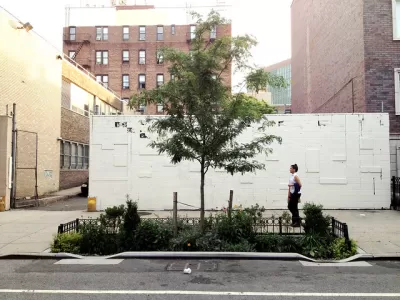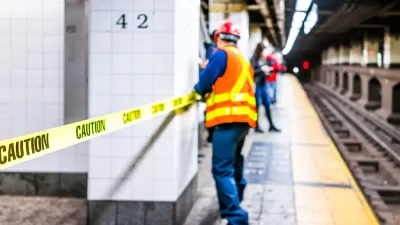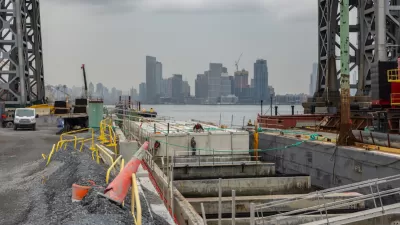To reduce the severity of disruptive subway flooding, the city can implement street-level solutions that absorb and redirect water before it reaches the train tunnels.

As climate change all but assures more catastrophic flooding in New York City, "experts say the city and the MTA can at least work on mitigating the worst of the floods by going green. Literally." To protect the city's subways and mitigate future floods, writes Dave Colon, "it’s incumbent on the city to create streets and sidewalks that can actually absorb water."
New York's subway system, according to the MTA, "can only handle rainfall of 1.75 inches per hour — an amount that used to be considered extremely rare, but isn’t anymore." In a 2018 lawsuit against Big Oil, the de Blasio administration acknowledged the increased risk by pointing out that "the number of days in New York City with rainfall at or above two inches is projected to increase by as much as 67% by the 2020s and the number of days with rainfall at or above four inches is projected to increase by as much as 67% by the 2020s and 133% by the 2080s."
Colon argues that "[s]treet design is a necessary, but neglected, weapon against flooding" that the city should implement more aggressively. And while experts praise the city's stormwater resiliency guide, Marcel Negret of the Regional Plan Association says the document takes "a siloed view of the transit system that the city relies on without owning," putting responsibility for flood prevention on the MTA without addressing street-level solutions like "street trees, bioswales and planters that manage excess stormwater."
FULL STORY: More Absorbent Streets Could Mean Less Flooded Subways

Alabama: Trump Terminates Settlements for Black Communities Harmed By Raw Sewage
Trump deemed the landmark civil rights agreement “illegal DEI and environmental justice policy.”

Planetizen Federal Action Tracker
A weekly monitor of how Trump’s orders and actions are impacting planners and planning in America.

Why Should We Subsidize Public Transportation?
Many public transit agencies face financial stress due to rising costs, declining fare revenue, and declining subsidies. Transit advocates must provide a strong business case for increasing public transit funding.

Understanding Road Diets
An explainer from Momentum highlights the advantages of reducing vehicle lanes in favor of more bike, transit, and pedestrian infrastructure.

New California Law Regulates Warehouse Pollution
A new law tightens building and emissions regulations for large distribution warehouses to mitigate air pollution and traffic in surrounding communities.

Phoenix Announces Opening Date for Light Rail Extension
The South Central extension will connect South Phoenix to downtown and other major hubs starting on June 7.
Urban Design for Planners 1: Software Tools
This six-course series explores essential urban design concepts using open source software and equips planners with the tools they need to participate fully in the urban design process.
Planning for Universal Design
Learn the tools for implementing Universal Design in planning regulations.
Caltrans
Smith Gee Studio
Institute for Housing and Urban Development Studies (IHS)
City of Grandview
Harvard GSD Executive Education
Toledo-Lucas County Plan Commissions
Salt Lake City
NYU Wagner Graduate School of Public Service





























